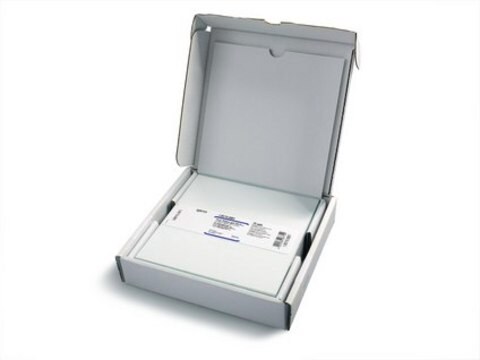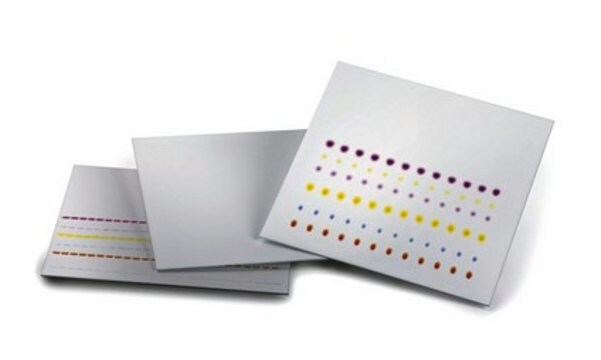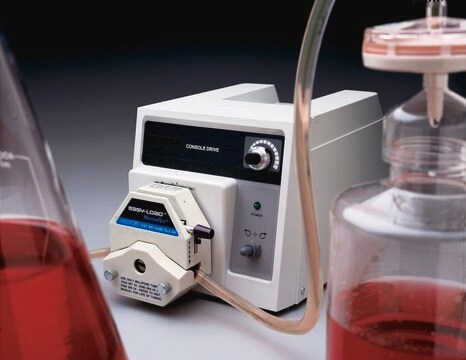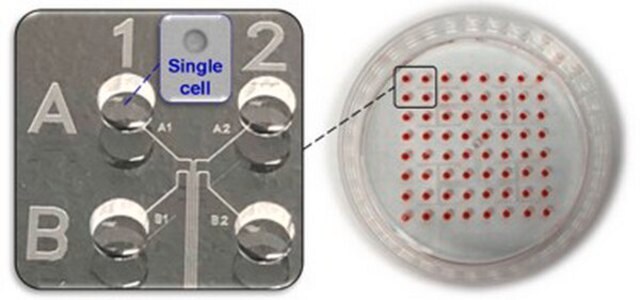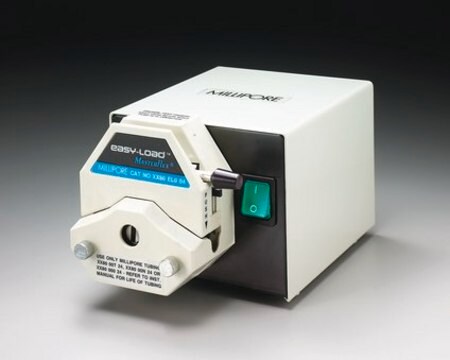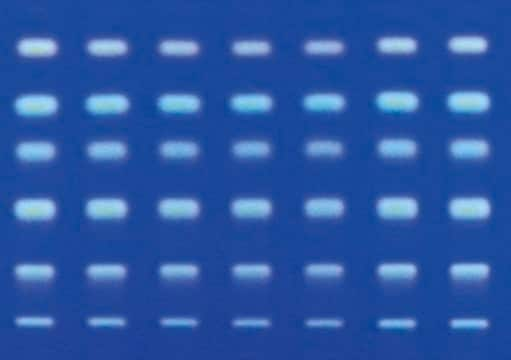1.05632
TLC plates, Cellulose
pkg of 100 plates, plate L × W 10 cm × 10 cm, glass support
Synonyme(s) :
Cellulose Thin Layer Chromatography Plates
Se connecterpour consulter vos tarifs contractuels et ceux de votre entreprise/organisme
About This Item
Code UNSPSC :
41115711
Nomenclature NACRES :
NB.21
Produits recommandés
Matériaux
cellulose matrix
glass support
Niveau de qualité
Caractéristiques
binder Organic Polymer
fluorescent indicator: no
Conditionnement
pkg of 100 plates
Technique(s)
thin layer chromatography (TLC): suitable
Épaisseur de la couche
80-120 μm
Plaque/Plateau, L × l
10 cm × 10 cm
Température de stockage
2-30°C
Catégories apparentées
Description générale
100 Glass plates 10 x 10 cm
Our cellulose plates are used to analyze polar substances. An organic sorbent, cellulose is perfect for separating hydrophilic substances by partition chromatography. Typical applications include the analysis of amino acids, carbohydrates, and phosphates as well as nucleic acid and nucleic acid derivatives. We offer cellulose plates in two grades: TLC for conventional and HPTLC for demanding, high-performance separations.
Application
- A Purification and In Vitro Activity Assay for a (p)ppGpp Synthetase from Clostridium difficile.: This article details the purification and activity assay of a synthetase enzyme using cellulose TLC plates, highlighting its significance in microbial research (Pokhrel et al., 2018).
- Production of Xanthanases by Paenibacillus spp.: Complete Xanthan Degradation and Possible Applications.: The study investigates xanthan degradation by enzymes produced by Paenibacillus spp., utilizing cellulose TLC plates for analysis, indicating potential industrial applications (Ashraf et al., 2017).
- Thin-layer chromatography combined with diode laser thermal vaporization inductively coupled plasma mass spectrometry for the determination of selenomethionine and selenocysteine in algae and yeast.: This research combines TLC with advanced mass spectrometry techniques to analyze selenium compounds in biological samples, showcasing the utility of cellulose TLC plates in bioanalytical chemistry (Bednařík et al., 2018).
- Analysis of low active-pharmaceutical-ingredient signal drugs based on thin layer chromatography and surface-enhanced Raman spectroscopy.: This study demonstrates the combination of TLC and Raman spectroscopy for the analysis of pharmaceuticals, emphasizing the effectiveness of cellulose TLC plates in drug analysis (Li et al., 2016).
- Fast assessment of planar chromatographic layers quality using pulse thermovision method.: This article presents a method for assessing the quality of chromatographic layers, including cellulose TLC plates, using thermovision techniques, which can enhance analytical reliability (Suszyński et al., 2014).
Liaison
Replaces: 5632-5; 5632
Remarque sur l'analyse
Layer thickness: 80 - 120 µm
Deviation of layer thickness per plate: ≤ 30 µm
Aminoacid test
hRf-values
- L-serine, amino acid test:
20 - 30
- L-threonine, amino acid test: 29 - 36
- L-alanine, amino acid test: 30 - 40
- L-methionine, amino acid test: 49 - 60
- L-phenylalanine, amino acid test: 59 - 70
- L-leucine, amino acid test: 66 - 76
typical value determined on a plate
Eluent: 1-Butanol/ acetone/ acetic acid/ water (35/35/7/23 v/v/v/v) twice developed
Deviation of layer thickness per plate: ≤ 30 µm
Aminoacid test
hRf-values
- L-serine, amino acid test:
20 - 30
- L-threonine, amino acid test: 29 - 36
- L-alanine, amino acid test: 30 - 40
- L-methionine, amino acid test: 49 - 60
- L-phenylalanine, amino acid test: 59 - 70
- L-leucine, amino acid test: 66 - 76
typical value determined on a plate
Eluent: 1-Butanol/ acetone/ acetic acid/ water (35/35/7/23 v/v/v/v) twice developed
Certificats d'analyse (COA)
Recherchez un Certificats d'analyse (COA) en saisissant le numéro de lot du produit. Les numéros de lot figurent sur l'étiquette du produit après les mots "Lot" ou "Batch".
Déjà en possession de ce produit ?
Retrouvez la documentation relative aux produits que vous avez récemment achetés dans la Bibliothèque de documents.
Notre équipe de scientifiques dispose d'une expérience dans tous les secteurs de la recherche, notamment en sciences de la vie, science des matériaux, synthèse chimique, chromatographie, analyse et dans de nombreux autres domaines..
Contacter notre Service technique